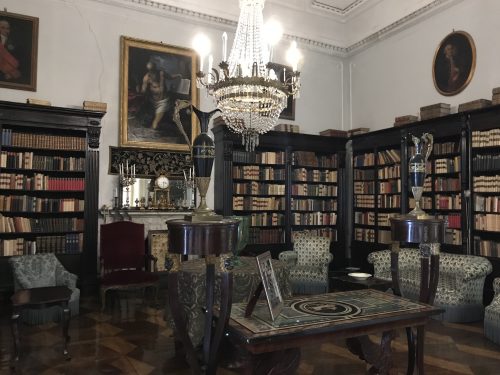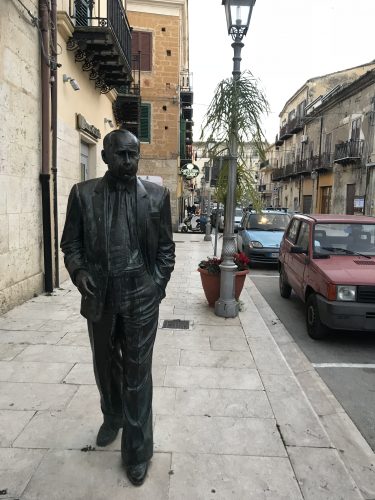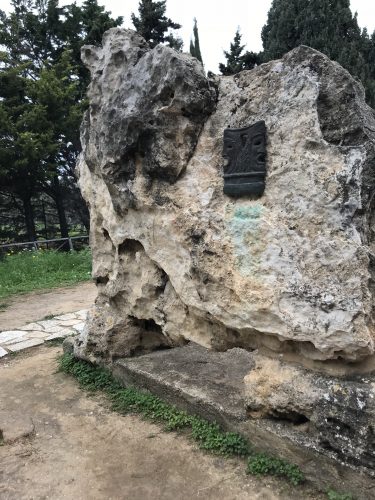Who says reading is an activity limited to your couch and a cup of tea? Over spring break, I had the chance to travel around to the homes, museums, and fictional locations of authors whose works I have been reading in my Italian literature course. My class teamed up with a Latin class to travel to Sicily, Italy. Over the course of ten days, we toured around the island, visiting ancient sites as well as literary sites related to the 20th century Sicilian writers we were studying. From statues to tombs to street signs, these Sicilian towns have all chosen different ways to preserve the legacy of these writers and their fictional characters, providing ample evidence (not that any of us needed it) that characters really do live off of the page.
 We began in Palermo, the political capital of the region, and visited sites associated with Giuseppe Tomasi di Lampedusa, a novelist whose most famous work, The Leopard, (1958) became an international hit and later a film starring Burt Lancaster. A member of the aristocratic class himself, Lampedusa wrote about the dying Italian aristocracy following Italy’s unification in the 19th century, a theme that becomes ironic when considering how regally his home has been preserved. Though the duchess (Lampedusa’s descendant) was not around to meet us, three UK university girls gave us a tour of Lampedusa’s mansion (photo #1 – click to view an enlarged image) , a space that now functions for tours, cooking classes with the duchess, room rentals, and, of course, residential space for the duchess and the rest of the family. The very formality of the tour ultimately made me feel as if I had walked into Lampedusa’s novel—a beautiful yet decaying house still trying to weather time’s efforts to make it irrelevant.
We began in Palermo, the political capital of the region, and visited sites associated with Giuseppe Tomasi di Lampedusa, a novelist whose most famous work, The Leopard, (1958) became an international hit and later a film starring Burt Lancaster. A member of the aristocratic class himself, Lampedusa wrote about the dying Italian aristocracy following Italy’s unification in the 19th century, a theme that becomes ironic when considering how regally his home has been preserved. Though the duchess (Lampedusa’s descendant) was not around to meet us, three UK university girls gave us a tour of Lampedusa’s mansion (photo #1 – click to view an enlarged image) , a space that now functions for tours, cooking classes with the duchess, room rentals, and, of course, residential space for the duchess and the rest of the family. The very formality of the tour ultimately made me feel as if I had walked into Lampedusa’s novel—a beautiful yet decaying house still trying to weather time’s efforts to make it irrelevant.
While Palermo is known for much more than Lampedusa, our next stop, Racalmuto, a small town near Agrigento, has dedicated itself  entirely to honoring its author Leonardo Sciascia, a prolific novelist and playwright who wrote incessantly about his hometown. This time, the author’s house was not accessible, so instead we visited a museum dedicated to Sciascia and his books, correspondences, and photographs. Museums can only do so much—afterwards, it was more moving to see Sciascia’s statue, hand in pocket, mid-stride, in the middle of the sidewalk in the center of town (photo #2- click to view an enlarged image). One could imagine not only the author taking his evening passeggiata through Racalmuto, but also the residents feeling comforted by the daily reminder of this author who has come to define it.
entirely to honoring its author Leonardo Sciascia, a prolific novelist and playwright who wrote incessantly about his hometown. This time, the author’s house was not accessible, so instead we visited a museum dedicated to Sciascia and his books, correspondences, and photographs. Museums can only do so much—afterwards, it was more moving to see Sciascia’s statue, hand in pocket, mid-stride, in the middle of the sidewalk in the center of town (photo #2- click to view an enlarged image). One could imagine not only the author taking his evening passeggiata through Racalmuto, but also the residents feeling comforted by the daily reminder of this author who has come to define it.
Throughout our journey, we saw more statues, museums, and apartments where characters from books had lived. Sometimes it felt like seeing someone famous, the thrill of imagining a fictional character walking in the same world as you. Sometimes it felt forced—is this what the author would have wanted? How to go about creating a legacy?
 One of our last stops was at the playwright Luigi Pirandello’s home in Porto Empedocle, bordering Agrigento. His actual home had been converted into a museum with his letters, manuscripts, and family’s paintings. More interestingly, his backyard now housed his tomb (Photo #3- click to view an enlarged image). The “tomb” was actually a large, strangely shaped rock. Behind it, a chunk of Pirandello’s favorite pine tree had been preserved. Our professor told us the story of Pirandello’s three funerals and how, ironically, Pirandello had asked in his will for there to be no fuss at all about his funeral. In his writing and life he tried to push against the “forms” that society tries to shape us into; this memorial, never mind the three funerals, would not have been what he wanted at all. And yet, people gave it to him anyway, and people continue, as we did, to visit his home and the sites he wrote about, in an attempt to see how literature manifests itself in real life.
One of our last stops was at the playwright Luigi Pirandello’s home in Porto Empedocle, bordering Agrigento. His actual home had been converted into a museum with his letters, manuscripts, and family’s paintings. More interestingly, his backyard now housed his tomb (Photo #3- click to view an enlarged image). The “tomb” was actually a large, strangely shaped rock. Behind it, a chunk of Pirandello’s favorite pine tree had been preserved. Our professor told us the story of Pirandello’s three funerals and how, ironically, Pirandello had asked in his will for there to be no fuss at all about his funeral. In his writing and life he tried to push against the “forms” that society tries to shape us into; this memorial, never mind the three funerals, would not have been what he wanted at all. And yet, people gave it to him anyway, and people continue, as we did, to visit his home and the sites he wrote about, in an attempt to see how literature manifests itself in real life.
So perhaps these literary travels are less an effort to pay homage to great writers and more an attempt for ourselves, as readers, to see the tangible ways books and their writers manifest themselves in real life. As much as books transport us to other worlds, there’s something thrilling and inspiring in the way we can trace just how much they’ve been influenced by the world we think we know so well.
Rachael is the Fictional Café’s Creative Nonfiction Barista. She graduates from Bowdoin College this spring.


